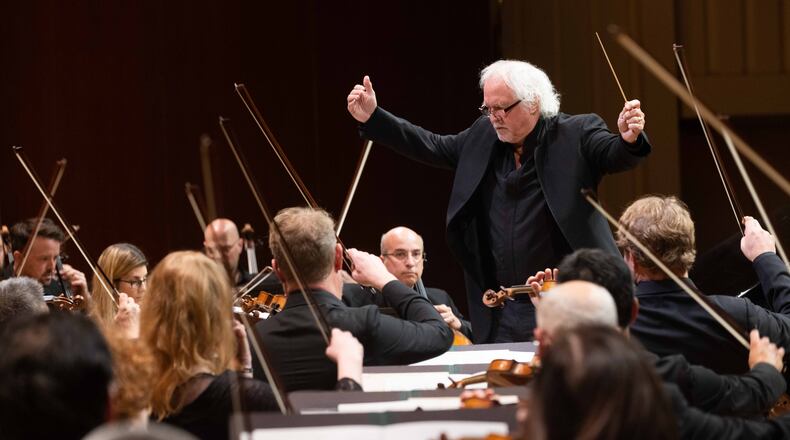Thursday felt like a special night in Symphony Hall. The Atlanta Symphony Orchestra has programmed the music of Florence Price before, as recently as last year, but for the first time the orchestra was celebrating the arrival of an important new voice.
Born in Arkansas, Price escaped the Jim Crow South as part of the Great Migration in the early 20th century, and launched what might have been — should have been — an important career as a composer. Her Symphony No. 1 won a prize and was performed by the Chicago Symphony in 1932 — the first time a major American orchestra performed music by a Black woman composer. Chicago asked Price for more. Marian Anderson sang one of Price’s Negro Spiritual arrangements at her historic 1939 concert on the steps of the Lincoln Memorial.
But for obvious reasons that track with much of U.S. history — “I have two handicaps, those of sex and race,” she wrote — her music did not gain wide acceptance. Several key works were published and remained in print after her death in 1953, allowing her to hover at the outer edge of the repertoire. She wasn’t so much forgotten as ignored. Over the past decade, she’s had several vociferous champions, including a former ASO assistant conductor, Mei-Ann Chen, who programs Price wherever an orchestra will accept it, from Chicago to San Diego to even the Alabama Symphony.
Credit: Jeff Roffman
Credit: Jeff Roffman
Thursday, to introduce Price’s Piano Concerto in One Movement from 1934, pianist Michelle Cann and conductor Donald Runnicles carried microphones to center stage. Cann, who teaches at Philadelphia’s prestigious Curtis Institute of Music and was here making her ASO debut, spoke excitedly of how this Concerto was known only through rehearsal parts, not a full score.
Miraculously, about a decade ago, the new owners of Price’s dilapidated old house in Illinois discovered boxes of her music in the attic. The full score to the Concerto and other major works — some “lost,” some unknown — were among them, and in 2018 most of this discovered music became public. (Hearing this sensational story, Runnicles put his foot in his mouth and acted all gobsmacked. “No one in classical music had ever heard of Florence Price!” he clucked. Coming from a conductor with an international career, it’s this willful ignorance — we might call it smugness — that led to Price’s forced obscurity.)
That’s a lot of heavy baggage for so charming and enjoyable a piece. Price’s Piano Concerto in One Movement opens with a brief, showy orchestral opening, and the piano soon takes over with power chords announcing a commanding solo part. Despite its rather short length, just under 20 minutes, it has the style and substance of the great piano concertos. It unfolds with familiar gestures and a late 19th-century soundworld, notably with a folksy vibe and African American idioms. For a composer, this blending of classical structure with vernacular language was a framework that Dvorak had made popular a generation earlier.
Credit: Jeff Roffman
Credit: Jeff Roffman
Although it’s titled “in one movement,” the piece is laid out clearly in three sections. The second, leisurely and agreeable, features a long, soulful oboe solo. It is backed by what sounded like expressive commentary from the piano, as call-and-response, with just a hint of melodious, blue-note Gershwin. Gorgeous.
The music then slides easily into the energetic final section, based on the Juba dance rhythm, aka the Hambone, joyous and free. Cann and Runnicles made a tight partnership throughout. The audience ate it up. Obviously, belatedly, this satisfying concerto is ripe to enter the symphonic repertoire.
After intermission, Runnicles and the ASO did what they do best together: late-Romantic epics that are emotionally and spiritually deep — works like Mahler’s First Symphony. (In 2009, Runnicles led a performance of Mahler’s Sixth that remains one of the most moving experiences I’ve ever had in Symphony Hall.)
Expectations were sky-high for this Mahler, and the musicians on stage did not disappoint. The opening movement, of nature awakening and cuckoo calls, was light on its feet, at once weighty and firm and transparent. Runnicles kept the quick parts moving at an unusually good clip, although nothing felt too fast or, elsewhere, too ponderous. By the time the skies darken and the mood turned morbid, Runnicles had already heightened the contrasts, so it all felt organic and real. Here the first movement, a perfectly crafted quarter-hour of symphonic writing, was incredibly persuasive.
They played the rustic, heavy-boot dance of the second movement with bite and vigor. So vigorously, perhaps, that the orchestra paused to re-tune and re-adjust before continuing with the rest of the symphony. The rather carefree innocence of the first movements gives way to an embittered, grotesque attitude in the third movement. The throbbing, unyielding heartbeat from the timpani was especially creepy, and that macabre, minor-key version of the nursery rhyme “Frère Jacques” represents perhaps Death itself.
Runnicles let the drama unfold like a master storyteller, and he had us emotionally prepared for the roiling energy and manic declarations of the finale. It opens with a thunderclap, the exploration of Mahler’s inner battle of life over death, optimism over gloom. There’s a lot of music to play, both personal and cosmic, and in a few sections parts of the ensemble seemed to grow weary and a bit blurry. But they pulled it together by the end, where the triumphant brass fanfares were majestic and the beefed-up French horn section was tight.
Life is victorious, for now, and in the moments where Mahler’s mania subsides we get islands of calm and introspection — of triumph, of hope, of sweeping all of life’s anxieties under a big orchestral rug to think about later. Here’s where Runnicles’ approach, as we’ve come to expect these past two decades, shows its depth, its humanity.
The program repeats March 4 in UGA’s Hodgson Concert Hall in Athens and returns March 5 to Atlanta Symphony Hall. Both concerts start at 8 p.m.
Credit: ArtsATL
Credit: ArtsATL
MEET OUR PARTNER
ArtsATL (www.artsatl.org), is a nonprofit organization that plays a critical role in educating and informing audiences about metro Atlanta’s arts and culture. Founded in 2009, ArtsATL’s goal is to help build a sustainable arts community contributing to the economic and cultural health of the city.
If you have any questions about this partnership or others, please contact Senior Manager of Partnerships Nicole Williams at nicole.williams@ajc.com.
About the Author
Keep Reading
The Latest
Featured






